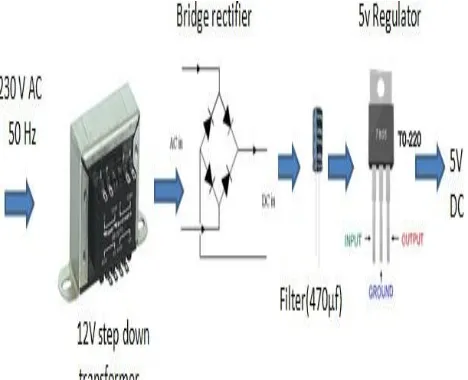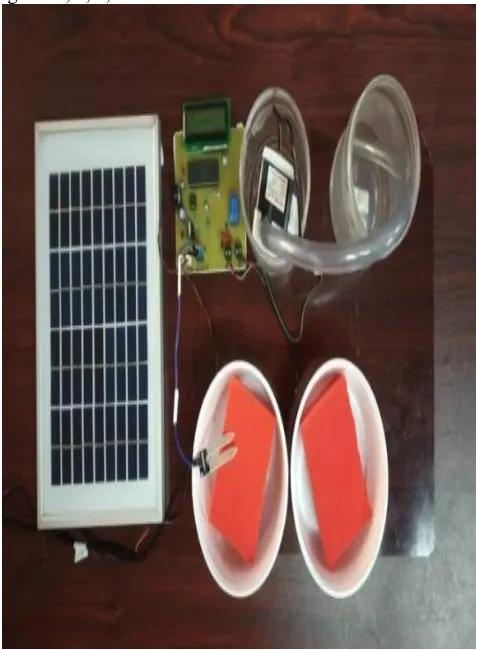International Journal of Innovative Technology and Exploring Engineering (IJITEE) ISSN: 2278-3075, Volume-9 Issue-2, December 2019
Abstract: : In the agriculture sector Continuous water extraction from the earth decreases water level owing to the slow arrival of a lot of soil in the areas of irrigated land. This is also owing to the unexpected use of water, which leads to a substantial quantity of waste. This automatic irrigation system is used for this purpose. Power comes from photovoltaic cells using solar energy. Therefore it is not necessary to rely on erratic business energy. The circuit consists of sensor components constructed with op-amp IC. Op-amps are set up as a comparator here. In the soil are placed two steep copper cables to see if the soil is moist or dry. The entire system is controlled by a microcontroller. IC which contacts are used to turn the engine ON, the engine is switched OFF when the ground is moist. The above task is carried out by the microcontroller, which receives the signal from the sensors and which functions under software control that can be stored on the microcontroller's Rom. The pump situation is shown on a 16X2 LCD interfacing to the microcontroller. The ON / OFF pump situation is shown. The project can also be strengthened through its interfaces with a GSM modem, which allows control of the engine switching.
Keywords : Automatic irrigation system, GSM Modem, Microcontroller, Operational amplifier, Photovoltaic cells,
I. INTRODUCTION
Irrigation is the apply water to the land or soil artificially. It is used to help farm crops grow, preserve the landscapes and replant disturbed soils in dry places and during insufficient pluvial periods. Water is a resource needed by all animals. This is why it is very valuable and to be used moderately in order to be maintained by future generations. Agriculture is a water-consuming sector. This resource is often not effectively deployed and significant quantities of water are disposed of. The waste will be a large sum of money in the near future. Time and money are won by those who handle this resource effectively. A automated irrigation scheme is recommended in this project to minimize the input of water and human intervention while satisfying the requirements of the plant. First, it summarizes the information of the issue. The project's goal and scope are outlined. Some overall design methods are examined. An experimental findings and findings are discussed for determining the necessary quantities of water. The proposed design is then described in detail with regard to each part's purpose, specifications and limitations, simulation, and test outcomes. In order to assess the viability of this project on the market, a short costs assessment is carried out.
Revised Manuscript Received on December 05, 2019.
* Correspondence Author
Dr.JARABALA RANGA, Professor, Dept of EEE, Ramachandra College of Engineering, Eluru, Andhra Pradesh, India.
Email: jarabalaranga@rcee.ac.in
Dr.B.S.SATHISH, Professor / Research Head, Dept of ECE, Ramachandra College of Engineering, Eluru, Andhra Pradesh, India.
Email: bssathish@rcee.ac.in
Finally, the design is criticized and future improvements are suggested. The system is operated without the manual participation of people by an automatic irrigation system. With the assistance of digital devices and detectors such as computers, timers, sensors and another mechanical device, any irrigation system, such as drip, sprinkler and the ground, is automated.
II. PROPOSED SYSTEM
[image:1.595.316.538.403.616.2]Inserted into the ground for a sense of moist and dry ground, the whole system is controlled by a microcontroller through sensors and when the devices feel dry soil conditions, the microcontroller sends the IC command, which contacts are used to turn on the engine, and turn the engine off when the soil is wet. This function is carried out by the microcontroller when it gets the signal from the sensors via the output of the comparator, which are controlled by the software stored in the ROM of the microcontroller. The pump condition-ON / OFF-is shown on the 16X2 LCD interface with the control unit as shown in figure 1.
Fig. 1. Block diagram of the proposed hardware setup
Hardware setup components used in the project:
POWER SUPPLYBLOCK
MICROCONTROLLER (AT89S52/AT89C51)
LCD DISPLAY
LM358(COMPARATOR)
SOLARPANEL
MOC3021
BC547
IN4007
An Automated Plant Irrigation System using µC
LED
RESISTORS
CAPACITRSSoftware Requirements:
KEILCOMPILER
LANGUAGES: EMBEDDED C or ASSEMBLYA. Design of Power Supply (12v & 5v Combo Power Supply)
[image:2.595.53.287.264.454.2]Each circuit is powered at a separate voltage, some circuits run at 5V, 9V, etc. However, if we use the ATMEGA 16-bit microcontroller for this project, we need a 5V power supply because the ATMEGA 16 bit microcontroller voltage is 5V. In this project we will be operating 5V and 12V. It could damage your microcontroller if you have more than 5V voltage as shown in figure 2.
Fig. 2. Block Diagram of Power Supply B. Filters
After rectification, the dc present filtering method is performed by means of a filling, because the output includes some ribbons or distortion can be said. So we don't use a 50V 1000uF condenser to filter these distortions. Instead of a 50V 1000uF capacitor, you can also use a 25V 1000uF or
[image:2.595.314.538.320.472.2]35V 1000uF condenser as shown in figure 3
.
Fig. 3. Capacitor filtering connection
C. Voltage Regulator IC
The controller is a single chip that controls the rib-free rectified voltage to provide a continuous voltage. The circuit
with a 12V and 5V controller. The percentage control or merely the energy supply regulator is determined:
% Regulation = [(Vmax – Vmin)/Vmax] × 100 In a general form
% Regulation = [(Vno load – Vfull load)/Vfull load] × 100 The controlled output is supplied by the voltage regulator. Many ICs on the market are accessible for the voltage regulator. We use LM7805 for 5V dc output and LM7812 for 12V dc energy supply.
D. Relay Switching Circuit
This is an electromagnetic switch that is activated by the application of a current. A relay utilizes tiny streams to change enormous streams. Most relays use the electromagnetic principle for functioning but still other principles of operation such as solid state are used. A contactor is a relay form that can manage a large energy needed to directly regulate the electrical engine or other loads. Solid government relays do not have moving components and are switched with semiconductor devices as shown in figure 4, table I and figure 5.
[image:2.595.47.289.576.733.2]International Journal of Innovative Technology and Exploring Engineering (IJITEE) ISSN: 2278-3075, Volume-9 Issue-2, December 2019
Table- I: The relay with various test conditions is tabulated
S.No
Voltage range
Soil
condition Q
Amplifier output (digital)
Relay reference
pin voltage
Relay 'NO' contact
Water pump operation
1 > 5V Excess wet 0 1 1 open OFF
2 < 5V & > 3V
Optimally 0 1 1 open OFF
Optimally
Dry
1 0 0
closed ON
3 < 3V Dry 1 0 0 closed ON
Fig. 5. Flow chart of program executed by µC
[image:3.595.307.546.319.644.2]III. RESULT AND DISCUSSION The hardware set up with output results are shown in figures 6, 7, 8, 9 and 10.
Fig. 7. Hardware setup of the proposed irrigation system using solar power under soil dry
[image:4.595.312.543.53.337.2]condition
Fig. 8. Hardware setup showing soil dry condition and status of the pump in ON condition
Fig. 9. Hardware setup of the proposed irrigation system using solar power under soil wet
[image:4.595.308.545.343.663.2]condition
[image:4.595.53.284.389.679.2]International Journal of Innovative Technology and Exploring Engineering (IJITEE) ISSN: 2278-3075, Volume-9 Issue-2, December 2019
IV. CONCLUSION
Thus, the “Automated Irrigation System using Solar Power” has They were effectively intended and tested. Integrated characteristics of all used hardware parts have been created. Each module has been thoroughly reasoned and positioned, thereby contributing to the unit's best work. The Automatic Soil Moisture Irrigation System with Microcontroller has therefore been effectively intended and tested.
REFERENCES
1. S. V. Devika, Sk. Khamuruddeen, Sk. Khamurunnisa,Jayanth Thota, Khalesha Shaik, “Arduino Based Automatic Plant Watering System”, Devika et al., International Journal of Advanced Research in Computer Science and Software Engineering 4(10), October -2014, pp. 449-456 Volume 4, Issue 10, October 2014
2. Deweshvree Rane, P.R. Indurkar, D.M. Khatri, “Review Paper Based On Automatic Irrigation System Based On RF Module”, IJAICT Volume 1, Issue 9, January 2015
3. Archana P, Priya R, “DESIGN AND IMPLEMENTATION OF AUTOMATIC PLANT WATERING SYSTEM”, International Journal of Advanced Engineering and Global Technology Vol-04, Issue-01 , January 2016, ISSN No: 2309-4893
4. S. Darshna, T.Sangavi, Sheena Mohan, A.Soundharya, Sukanya Desikan, “Smart Irrigation System”, IOSR Journal of Electronics and Communication Engineering (IOSRJECE) e-ISSN: 2278-2834,p-ISSN: 2278-8735.Volume 10, Issue 3, Ver. II (May-Jun.2015), PP 32-36 5. Pavithra D.S, M.S.Srinath, “GSM based Automatic Irrigation Control
System for Efficient Use of Resources and Crop Planning by Using an Android Mobile”, IOSR Journal of Mechanical and Civil Engineering (IOSR-JMCE) e-ISSN: 2278-1684,p-ISSN: 2320-334X, Volume 11, Issue 4 Ver. I (Jul-Aug. 2014), PP 49-55
6. Y. P. Patil, N. D. Pergad,” Review Paper on GSM based Water Management in Irrigation System Using ARM7”, International Journal of Science and Research (IJSR) ISSN (Online): 2319-7064 Index Copernicus Value (2013): 6.14 | Impact Factor (2014): 5.61
7. Karan Kansara, Vishal Zaveri, Shreyans Shah, Sandip Delwadkar, Kaushal Jani, “Sensor based Automated Irrigation System with IOT: A Technical Review”, Karan Kansara et al, / (IJCSIT) International Journal of Computer Science and Information Technologies, Vol. 6 (6), 2015, 5331-5333
8. Yogesh G. Gawali, Devendra S. Chaudhari, Hitendra C. Chaudhari, “A Review on Automated Irrigation System using Wireless Sensor Network” ,International Journal of Advanced Research in Electronics and Communication Engineering (IJARECE) Volume 5, Issue 6, June 2016 ISSN:2278 –909X
AUTHORS PROFILE
Dr.JARABALA RANGA, Professor and
Research Development coordinator , Dept of EEE, Ramachandra College of Engineering, Eluru, Andhra Pradesh, India..



